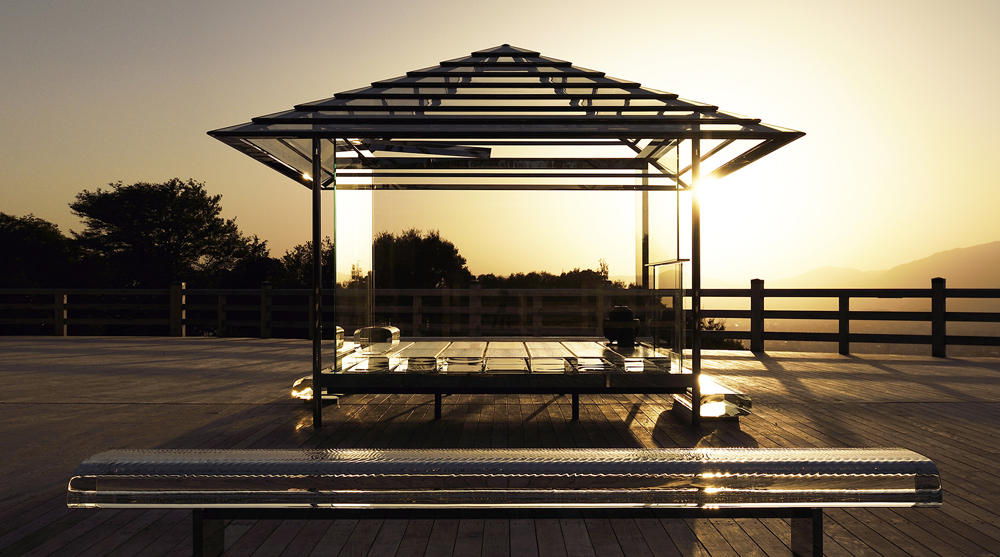Teahouses are recognised for their simplicity in design and the quiet space they create for guests. Though most common in Japan, unique and iconic teahouses can be found in countries all over the world, each with their own take on recreating the tea-making ritual.
Too High Tea House (Terunobu Fujimori)

Takasugi-an translates to literally mean “a tea house too high”. Image source
Terunobu Fujimori’s Takasugi-an translates to literally mean “a tea house too high”, an apt name for the iconic teahouse/treehouse located in Chino, Nagano Prefecture, Japan. The teahouse can only be accessed by a ladder, where guests can enjoy a one of a kind tea-making experience atop two chestnut trees.
Fujimori followed the tradition of tea masters and designed and built the Too High Tea House for his own use and has even commented that a teahouse is “the ultimate personal architecture”. Simplicity is traditionally more important than extravagance, and the Too High Teahouse follows that tradition with only just enough room to accommodate four and a half tatami mats at 2.7 square meters each.
The room displays a large window that frames the perfect bird’s eyes’ view of the town where the architect grew up, where his first ever architecture project is actually visible in the distance.
Tokujin Yoshioka, Kou-an Glass Teahouse

The glass teahouse was developed as part of a larger transparent house project. Image source
Artist and designer Tokujin Yoshioka’s Glass Teahouse project originated in the plans of the Transparent Japanese House which the architect first presented in 2002. The idea was eventually developed into a transparent teahouse, incorporating a symbolic Japanese cultural image. Constructed facing the historic Shoren-in Temple in Kyoto, the Glass Teahouse offers guests an expansive view of the city as well as the Higashiyama Mountains.
While it lacks some of the more traditional aspects of a teahouse - such as flowers and hanging scrolls - it makes up for it with a constant array of rainbows cast on the floors due to the structure’s prism effect that the designer describes as “flower of light.”
“What I wanted to do through this project is not just to express the regeneration of tradition and history by modern design,” said Yoshioka, “but to think about and trace [the cultural significance of] the tea ceremony.”
Boa Nova Tea House (Álvaro Siza)

The Boa Nova Tea House has since been converted into a high-class restaurant. Image source
The Boa Nova Tea House was originally completed back in 1963, just nine years after Álvaro Siza first began his architectural practice. Though the teahouse has since been repurposed into a restaurant, many of the original features were restored and incorporated into the new design.
The external surfaces were a mixture of white-plastered masonry and exposed concrete pillars and were repaired to look like new, even though they are over 50 years old.
The restaurant also retained the teahouses double-height atrium entrance, guiding visitors down a white stone pathway that leads past a series of large boulders.
The teahouse-turned-restaurant is situated on rocky terrain that faces down towards the seafront, taking advantage of stunning natural views.
The Fata Morgana Teahouse (Wolfgang Winter and Berthold Hörbelt)

Consisting of a steel pavilion, the Fata Morgana Teahouse invites audiences to see the area from a new perspective. Image source
Inspired by the Anglo Saxon poem ‘The Wanderer’ artists Wolfgang Winter and Berthold Hörbelt worked with masterplanners AECOM to create the Fata Morgana Teahouse in North West Cambridge, UK. In the poem, the Wanderer moves about without destination or purpose, and this journey triggers an internal process of reflection and contemplation. The artists looked to inspire a similar state of reflection to those guests visiting the teahouse.
Consisting of a steel pavilion, the Fata Morgana Teahouse invites audiences to see the area from a new perspective, offering little in the way of distraction, or in fact any tea.
The artists have established in their practice a deep understanding of how public space has the potential to inspire anyone, even those who may not have any interest in public art at all, creating places where people can meet and reflect and experience their surroundings.
Interested in small scale architecture? Find out more here - Buildner Small Scale Architecture Appreciation Movement!
Top 3 Reasons Why You Should Enter Architecture Competitions
Curious about the value of architecture competitions? Discover the transformative power they can have on your career - from igniting creativity and turning designs into reality, to gaining international recognition.
Learn more


























